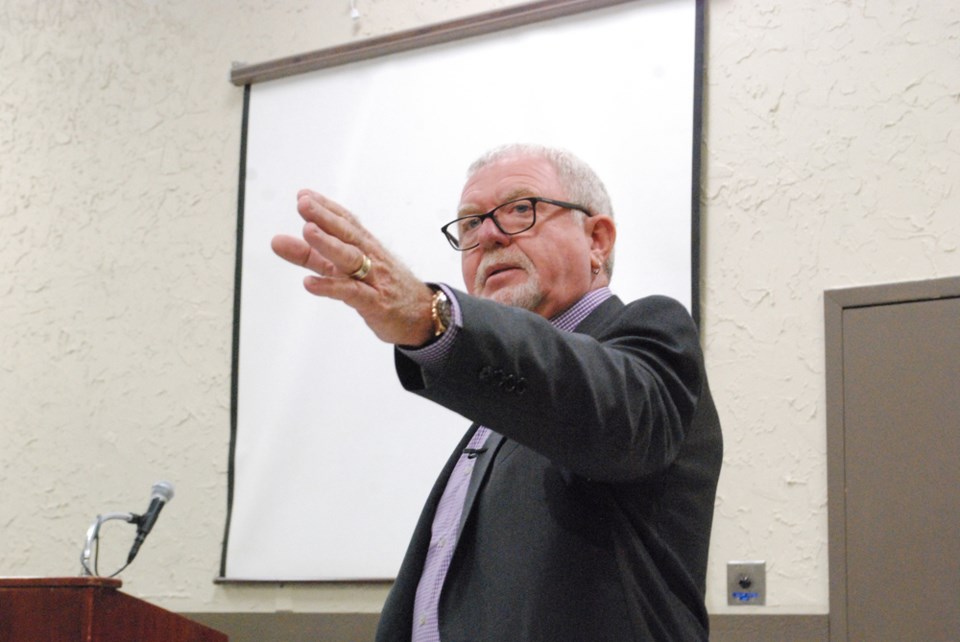Mark Wafer wears two hats when he discusses disability employment.
As a businessman himself as well as a person with a disability, he knows the nature of both worlds.
Thanks to the Humboldt and District Community Services and Sagehill Community Future, Wafer was able to discuss these worlds in Humboldt on Oct. 26 during his community presentation on inclusive employment.
Business persons do not realize how big a demographic are living with a disability, says Wafer, with 20 per cent of the Canadian population living with a disability.
Many of these disabilities are invisible, with only eight per cent of people using scooters and wheelchairs and seven per cent having intellectual disabilities.
The biggest focus of Wafer’s talk was about how employing people with disability needs to work for the employer.
In the past, the disability employment model was focused on the individual. Making the model business focused is creating better opportunities for both employers and employees.
Businesses have to understand how this would benefit them in a language they would understand, says Wafer.
“They’re driven by profits, not because they’re greedy, but because they have to. If you stagnate in business, you’re dead.”
Tapping into that mind-set is important, says Wafer, as there are many benefits to hiring people with disabilities.
The big one for Wafer was a low turnover rate for people with disabilities.
The quick service restaurants sector, which Tim Hortons is a part of, turnover rate is typically 125 per cent a year.
In Wafer’s six locations during a 10 year period, turnover rate is 40 per cent.
The cause? Being an inclusive employer changes the game, says Wafer.
“In some labour markets across Canada, including where I live in Ontario, where we have a tremendous shortage of workers, that we start to work very seriously at the disability community. That is going to solve your problem.”
Wafer had spent 25 years as a business owner where he hired over 200 people with disabilities to work in his Tim Hortons locations. When Wafer sold his business just a few weeks before coming to Humboldt, he had 46 employees with disabilities in a 250 person workforce.
The absentee rate for those 46 employees was 85 per cent lower than all his other workers combined, he says.
“Looking at from the dollars and cents, absenteeism is very expensive for business.”
Safety ratings are also higher for employees with disabilities since they are less likely to cut corners and are aware of their environment and limitations, says Wafer.
“An employee with cerebral palsy and is using a wheelchair, is not going to climb out of that wheelchair and onto a step ladder to get something off the top shelf because it’s not safe...someone else who is not disabled might climb up on a milk crate.”
That is how accidents happen, says Wafer, and he has seen that before.
Being aware of limitations also makes people with disabilities problem solvers, says Wafer, since they have different problems compared to people without disabilities.
“That makes them innovators in the workforce. It’s not created by hiring brilliant people, it’s created by hiring regular people with different problem solving skills,” says Wafer.
However, speaking from one businessman to another usually has more of an impact on creating disability employment awareness.
Wafer’s “the Baker’s Dozen”, speaks to his own expectations when hiring people with disabilities.
The most important message is to develop business champions who are able to help get doors open for disability employment opportunities.
Business people are afraid of what they do not understand, says Wafer, so it is important that job developers and social service sector employees have business champions to explain how hiring someone in a meaningful and competitive position has worked out for them.
And the Humboldt business community came to the table for the discussion with many Humboldt employers, community members, and city councillors who are already involved in inclusive employment coming to listen to Wafer, says Niamh Menz with Humboldt and District Community Services.
“Hearing it from a different perspective was very eye opening for them. Maybe it was a change in the vernacular that used or different way that (Wafer) discussed it, focusing on the bottom line and how it is key for business.”
Menz can see how inclusive employment works, since employers are looking into how to include more people in their business, she says.
“People are more curious about different ways of approaching this.”
Mark Wafer’s Baker’s Dozen for Inclusive Employment
1) Create business champions in your community and let them do the heavy lifting for you.
2) Have increased expectations of your client.
3) View the business as your most important client.
4) Encourage families and stakeholder groups to speak with children early in life about work.
5) The approach to business must be at all times the “business case”.
6) Develop relationships with business before approaching them to hire your clients.
7) Apply for jobs where jobs exist.
8) Avoid wage subsidies at all costs.
9) Never take a client on a cold call.
10) Understand the wants and wishes of your client.
11) It is critical that your initial approach to a business be with the companies owner or if it is a corporation, the CEO.
12) Consider yourself and your agency as a major force in town.
13) Dress for success.
Courtesy of Mark Wafer ‘s LinkedIn Page



